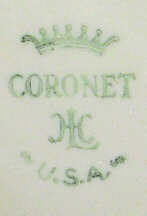 Coronet was a line of dinnerware made by the Homer Laughlin China Company from 1935 until the mid-1940s.
Coronet was a line of dinnerware made by the Homer Laughlin China Company from 1935 until the mid-1940s.
At the end of September 1934, designer Frederick Rhead worked on several 9" plates with various types of flutes on the rim, as well as versions with floral embossing on the verge. One of the fluted plates with embossing was approved on October 5, 1934, and ordered development to commence. Rhead was very optimistic about the shape and noted in his journal it was "different from anything on the market."
Modeling the rest of the Coronet shape was put on hold for several weeks while the Art Department worked on expanding the Marigold line which had recently been put into production, as well as some OvenServe pieces for Royal Metal. At the end of November, work began on what was then called the "fluted" or sometimes "paneled" shape. The line was officially named Coronet in the first week of December. Special backstamp drawings for both Coronet and Royal Metal were delivered to The Quality Stamp Company (producers of backstamps for many potteries in the area) on December 4, 1934.
By the end of January 1935, most of the Coronet pieces were finished. There was only on problem item; the handled soup bowl. The original plan was to make a cream soup cup - a low bowl with handles at either side. However, this was changed to an onion soup. Onion soups are usually taller than cream soups and have lug handles. (In the case of Fiesta, the onion soup was made with a lid.) The Coronet onion soup was modeled in December 1934, but on January 1, 1935, Rhead notes experimenting with a potential replacement. He took the lug soup, cut off the lugs, and applied the sugar bowl handles. This version was never put into production.
Two different sugars were made for Coronet, the covered sugar and the open sugar. The open sugar was modeled with a smooth opening. Covered sugar bases were made with a flange to accept the lid.
Some of Coronet's first treatments were hand-painted embossing work. Polychrome, a combination of yellow, green, blue, and red, was the first of these. Other colors would follow in the same manner as those used on Marigold and OvenServe. Coronet is found mainly with decals, but there were many platinum and gold stamp treatments as well. A few underglaze transferware patterns were also used.
Coronet in solid colors can be difficult to find. Melon yellow, sea green, and ivory are the only ones found thus far. These were marked with either the standard Coronet backstamp or a Wells Art Glazes marking. At one point, Rhead suggested making an inexpensive line of Coronet in Fiesta glazes. However, Rhead eventually noted that Coronet in Fiesta glazes would, "cost as much as Fiesta."
|